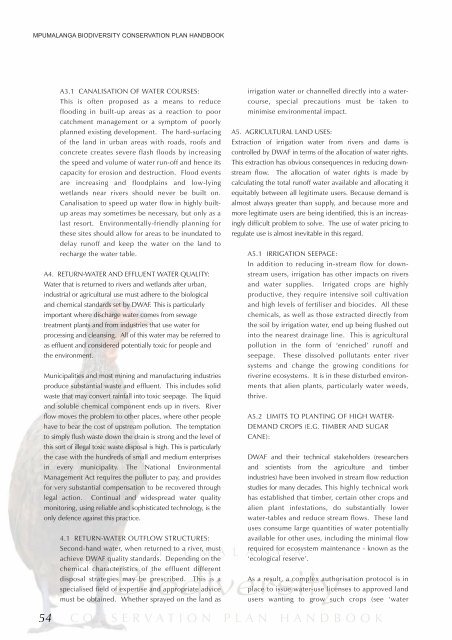Mpumalanga Biodiversity Conservation Plan Handbook - bgis-sanbi
Mpumalanga Biodiversity Conservation Plan Handbook - bgis-sanbi
Mpumalanga Biodiversity Conservation Plan Handbook - bgis-sanbi
You also want an ePaper? Increase the reach of your titles
YUMPU automatically turns print PDFs into web optimized ePapers that Google loves.
MPUMALANGA BIODIVERSITY CONSERVATION PLAN HANDBOOK<br />
54<br />
A3.1 CANALISATION OF WATER COURSES:<br />
This is often proposed as a means to reduce<br />
flooding in built-up areas as a reaction to poor<br />
catchment management or a symptom of poorly<br />
planned existing development. The hard-surfacing<br />
of the land in urban areas with roads, roofs and<br />
concrete creates severe flash floods by increasing<br />
the speed and volume of water run-off and hence its<br />
capacity for erosion and destruction. Flood events<br />
are increasing and floodplains and low-lying<br />
wetlands near rivers should never be built on.<br />
Canalisation to speed up water flow in highly builtup<br />
areas may sometimes be necessary, but only as a<br />
last resort. Environmentally-friendly planning for<br />
these sites should allow for areas to be inundated to<br />
delay runoff and keep the water on the land to<br />
recharge the water table.<br />
A4. RETURN-WATER AND EFFLUENT WATER QUALITY:<br />
Water that is returned to rivers and wetlands after urban,<br />
industrial or agricultural use must adhere to the biological<br />
and chemical standards set by DWAF. This is particularly<br />
important where discharge water comes from sewage<br />
treatment plants and from industries that use water for<br />
processing and cleansing. All of this water may be referred to<br />
as effluent and considered potentially toxic for people and<br />
the environment.<br />
Municipalities and most mining and manufacturing industries<br />
produce substantial waste and effluent. This includes solid<br />
waste that may convert rainfall into toxic seepage. The liquid<br />
and soluble chemical component ends up in rivers. River<br />
flow moves the problem to other places, where other people<br />
have to bear the cost of upstream pollution. The temptation<br />
to simply flush waste down the drain is strong and the level of<br />
this sort of illegal toxic waste disposal is high. This is particularly<br />
the case with the hundreds of small and medium enterprises<br />
in every municipality. The National Environmental<br />
Management Act requires the polluter to pay, and provides<br />
for very substantial compensation to be recovered through<br />
legal action. Continual and widespread water quality<br />
monitoring, using reliable and sophisticated technology, is the<br />
only defence against this practice.<br />
4.1 RETURN-WATER OUTFLOW STRUCTURES:<br />
M P U M A L A N G A<br />
Second-hand water, when returned to a river, must<br />
<strong>Biodiversity</strong><br />
achieve DWAF quality standards. Depending on the<br />
chemical characteristics of the effluent different<br />
disposal strategies may be prescribed. This is a<br />
specialised field of expertise and appropriate advice<br />
must be obtained. Whether sprayed on the land as<br />
irrigation water or channelled directly into a watercourse,<br />
special precautions must be taken to<br />
minimise environmental impact.<br />
A5. AGRICULTURAL LAND USES:<br />
Extraction of irrigation water from rivers and dams is<br />
controlled by DWAF in terms of the allocation of water rights.<br />
This extraction has obvious consequences in reducing downstream<br />
flow. The allocation of water rights is made by<br />
calculating the total runoff water available and allocating it<br />
equitably between all legitimate users. Because demand is<br />
almost always greater than supply, and because more and<br />
more legitimate users are being identified, this is an increasingly<br />
difficult problem to solve. The use of water pricing to<br />
regulate use is almost inevitable in this regard.<br />
A5.1 IRRIGATION SEEPAGE:<br />
In addition to reducing in-stream flow for downstream<br />
users, irrigation has other impacts on rivers<br />
and water supplies. Irrigated crops are highly<br />
productive, they require intensive soil cultivation<br />
and high levels of fertiliser and biocides. All these<br />
chemicals, as well as those extracted directly from<br />
the soil by irrigation water, end up being flushed out<br />
into the nearest drainage line. This is agricultural<br />
pollution in the form of ‘enriched’ runoff and<br />
seepage. These dissolved pollutants enter river<br />
systems and change the growing conditions for<br />
riverine ecosystems. It is in these disturbed environments<br />
that alien plants, particularly water weeds,<br />
thrive.<br />
A5.2 LIMITS TO PLANTING OF HIGH WATER-<br />
DEMAND CROPS (E.G. TIMBER AND SUGAR<br />
CANE):<br />
DWAF and their technical stakeholders (researchers<br />
and scientists from the agriculture and timber<br />
industries) have been involved in stream flow reduction<br />
studies for many decades. This highly technical work<br />
has established that timber, certain other crops and<br />
alien plant infestations, do substantially lower<br />
water-tables and reduce stream flows. These land<br />
uses consume large quantities of water potentially<br />
available for other uses, including the minimal flow<br />
required for ecosystem maintenance - known as the<br />
‘ecological reserve’.<br />
As a result, a complex authorisation protocol is in<br />
place to issue water-use licenses to approved land<br />
users wanting to grow such crops (see ‘water<br />
CONSERVATION PLAN HANDBOOK

















